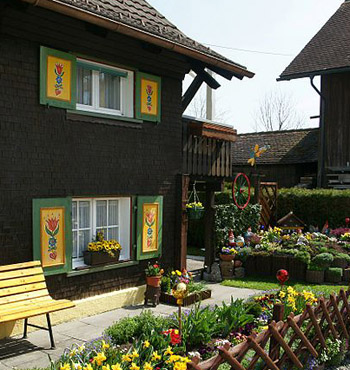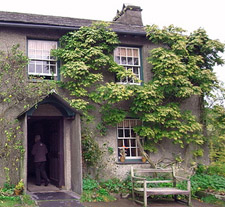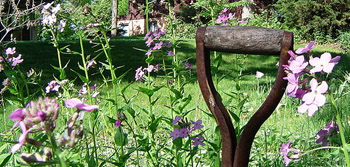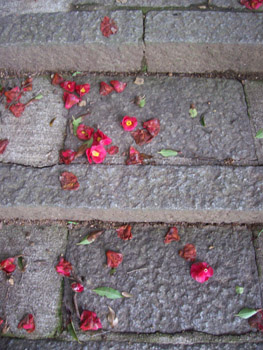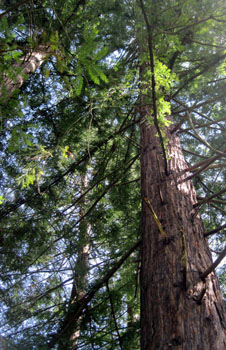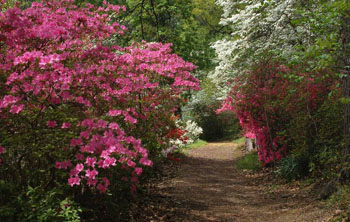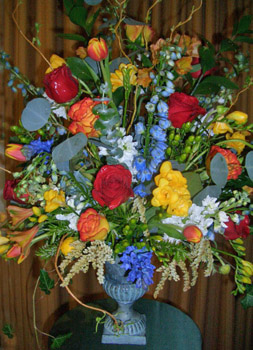
Winning Design Entry by Sue Redden
If you’ve been a garden club member for any length of time you probably have been exposed to The Standard Flower Show. The Standard Flower Show tradition started a very long time ago. But it is more than simply tradition. It basically—still and after all these years—sets out to educate and develop aesthetic sensibilities. If you’ve ever been swept up into its whirlwind you at least know this much.
Now, aside from horticulture entries, you may have been asked to try your hand at creating and entering a floral arrangement into the Design category. This request may have come about in the form of arm-twisting—in which case you definitely need some de-mystifying about how it will be judged.
And, voila, if you already have been on the receiving end of judging and scoring for your floral arrangement, you probably want to know just how that panel of three judges came to their decision of Honorable Mention.
So, for this post, I have consulted with Sue Redden, a demonstrator and winner of many blue ribbons and top NGC Exhibitor awards in Design and Horticulture. Sue has been a leading member of two garden clubs in Rhode Island for, well let’s just say, decades and she has filled board positions for the Rhode Island Federation of Garden Clubs Inc., the New England Region, and National Garden Clubs, Inc. She has judged Design and Horticultural exhibits in New England, Philadelphia, and Cleveland.
Here is Sue’s basic introduction to The Standard System of Awarding:
- The Flower Show’s “Schedule” is “the law.”
- The Handbook for Flower Shows is the ultimate authority for judging. [Accept no substitutes and get the latest edition. See below.*]
- Three people make up a judging panel and use The Standard System of Awarding.
- In a Standard Show, four arrangements would compete within the same pre-determined “schedule class.” [We’ll leave definitions of schedules and classes to another post.]
- Only one first place (blue) ribbon per class is awarded; must score 90 or above.
- Only one second place (red) ribbon per class; must score 85 or above,
- Only one third place (yellow) ribbon per class; must score 80 or above.
- One or more honorable mention (white) ribbons as merited; must score 75 or above.
Judges award the blue ribbon to the highest scoring design, again it must score 90 or above. (Note: There are times when multiple entries in the class achieve the sought-after 90+ score, and this 90 above score will be indicated.)
In order to win the top additional exhibitor awards—such as the Tricolor, Designer’s Choice—one must have scored 95 or more.
And here’s what the judges look for:
Scale of Points for Design
Conformance –20 points if all the requirements for the design are met.
Design – 42 points is the next consideration – 7 pts allowed for each of the following met principles:
Balance – Is the design visually stable?
Proportion – Is the design in proportion with its allotted space?
Scale – Are the components in scale with one another?
Rhythm – Does your eye carry through the design?
Dominance – Do one or more elements dominate?
Contrast – Is there interest in the design?
Artistic Concept – 12 points – Is there creative and appropriate selection and imaginative organization of all components according to the schedule guidelines?
Expression – 10 points – Has the exhibitor interpreted the class well?
Distinction – 16 points – Is the plant material conditioned? Does the exhibit have marked superiority in all respects?
And we have the TOTAL—a rarely attained 100 points.
Sue says:
“To win a top award a lot of thought must go into selection of plant material, color, texture, spikes, rounds, etc. and one must adhere to schedule parameters . . . i.e. read the show’s schedule carefully and follow directions!”
With subjective opinion, personal taste, and whim minimized as much as possible, the scoring standardization almost makes it appear as an exact science. Not quite—they are mortal beings after all—but judging is a learned art in and of itself.
To learn more about how to become a judge yourself, contact your state federated NGC Flower Show Schools Chairman for further information.
Also you might be interested in Flower Design Study Units. Explore here: http://www.gardenclub.org/FloralDesign/DesignStudyUnits.aspx
*The Handbook for Flower Shows, revised 2007 edition is available from NGC headquarters – Member Services. Order your copy by calling 800-550-6007. National Garden Clubs, Inc. 4401 Magnolia Avenue, St. Louis, Missouri, 63110-3492.
Let me know if you’d like to hear more about de-mystifying The Standard Flower Show!
Nancy R. Peck
Read Full Post »

